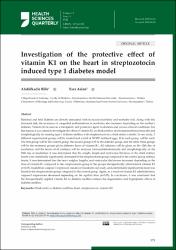| dc.contributor.author | Bilir, Abdülkadir | |
| dc.contributor.author | Aslan, Esra | |
| dc.date.accessioned | 2023-06-01T12:19:01Z | |
| dc.date.available | 2023-06-01T12:19:01Z | |
| dc.date.issued | 2022 | en_US |
| dc.identifier.citation | BİLİR, A., & Aslan, E. (2022). Investigation of the protective effect of vitamin K1 on the heart in streptozotocin induced type 1 diabetes model. Health Sciences Quarterly, 2(4), 179-186. | en_US |
| dc.identifier.issn | 2791-6022 | |
| dc.identifier.uri | https://dx.doi.org/10.26900/hsq.2.4.02 | |
| dc.identifier.uri | https://hdl.handle.net/20.500.12933/1575 | |
| dc.description.abstract | Maternal and fetal diabetes are directly associated with increased morbidity and mortality risk. Along with this increased risk, the incidence of congenital malformations in newborns also increases depending on the mother’s diabetes. Vitamin K1 is used as a therapeutic and protective agent in diabetes and various clinical conditions. For this reason, it was aimed to investigate the effect of vitamin K1 on chick embryo hearts immunohistochemically and morphologically by creating type 1 diabetes mellitus with streptozotocin in a chick embryo model. In our study, 5 different experimental groups will be created and a total of 50 SPF fertilized eggs, 10 in each group, will be used. The first group will be the control group, the second group will be the diabetes group, and the other three groups will be the treatment groups given different doses of vitamin K1. All solutions will be given on the 12th day of incubation, and the hearts of all embryos will be analyzed immunohistochemically and morphologically on the 18th day of incubation. It was determined that the weight, length and ventricular thickness of the chick embryo hearts were statistically significantly decreased in the streptozotocin group compared to the control group embryo hearts. It was determined that the heart weights, lengths, and ventricular thicknesses increased depending on the dose of vitamin K1 compared to the streptozotocin group in the groups therapeutically administered vitamin K1 (p<0.05). In addition, caspase-3 expression was also evaluated in our study, and a statistically significant increase was found in the streptozotocin group compared to the control group. Again, as a result of vitamin K1 administration, caspase-3 expressions decreased depending on the applied dose (p<0.05). In conclusion, it was concluded that the therapeutically applied vitamin K1 to diabetes mellitus reduces the degenerative and hyperplastic effects of diabetes mellitus. | en_US |
| dc.language.iso | eng | en_US |
| dc.publisher | Holistence Publications | en_US |
| dc.relation.isversionof | 10.26900/hsq.2.4.02 | en_US |
| dc.rights | info:eu-repo/semantics/openAccess | en_US |
| dc.subject | Chick Embryo | en_US |
| dc.subject | Diabetes Mellitus | en_US |
| dc.subject | Heart | en_US |
| dc.subject | Streptozotocin | en_US |
| dc.subject | Vitamin K1 | en_US |
| dc.title | Investigation of the protective effect of vitamin K1 on the heart in streptozotocin induced type 1 diabetes model | en_US |
| dc.type | article | en_US |
| dc.authorid | 0000-0003-0633-9542 | en_US |
| dc.department | AFSÜ, Tıp Fakültesi, Temel Tıp Bilimleri Bölümü, Anatomi Ana Bilim Dalı | en_US |
| dc.contributor.institutionauthor | Bilir, Abdülkadir | |
| dc.contributor.institutionauthor | Aslan, Esra | |
| dc.identifier.volume | 2 | en_US |
| dc.identifier.issue | 4 | en_US |
| dc.identifier.startpage | 179 | en_US |
| dc.identifier.endpage | 186 | en_US |
| dc.relation.journal | Health sciences quarterly (Online) | en_US |
| dc.relation.publicationcategory | Makale - Uluslararası Hakemli Dergi - Kurum Öğretim Elemanı | en_US |
















